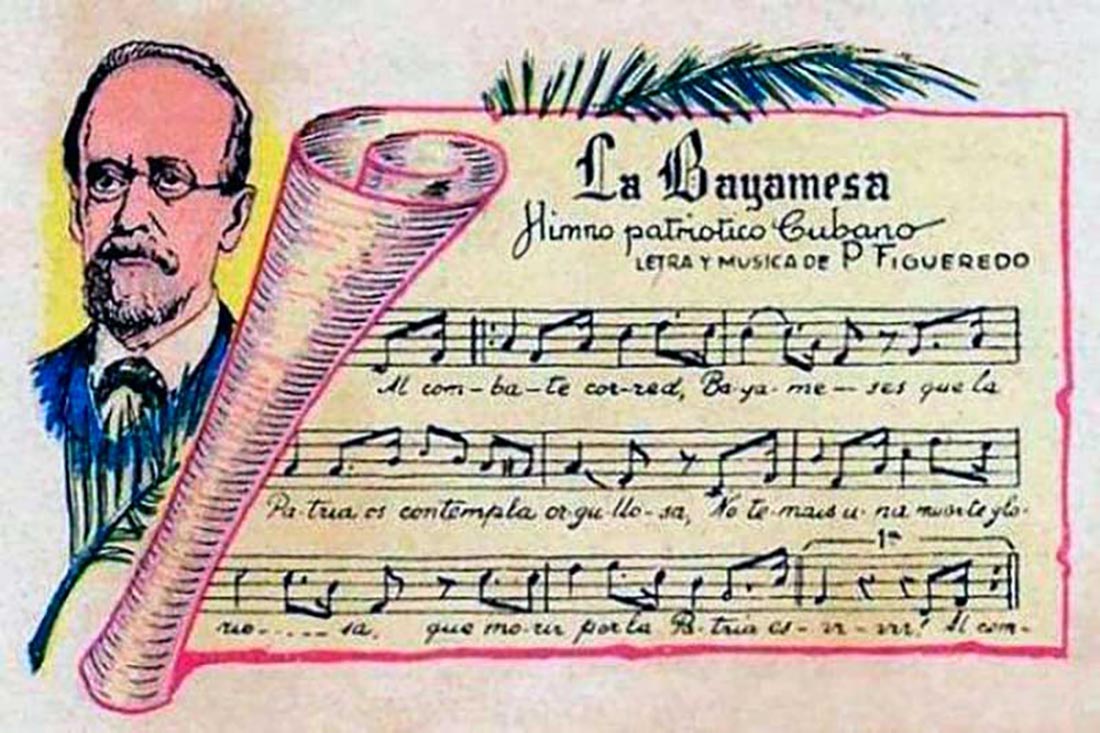Self-recognition through our national symbols is the manifestation of an identity assumed, felt and defended under the name of nation. That is why, on such an important date, the National Anthem ratifies the pride of being Cuban.
To understand what it represents, first, it is necessary to understand that symbols are capable of giving significant and comprehensive value to the facts or reality itself. Thanks to the use of figurative elements and images, human beings can give meaning, which allows them, on the one hand, to articulate and define the surrounding reality and, on the other, to communicate, express and define themselves in it.
Second, that their fixation and institutionalization as national symbols and integration of their components obey a historical process in which not only traditions converge, but also sociocultural evolution, through their own transcendence in history, as is well demonstrated bellow.
Bayamo anthem
Its birth is produced months before Yara’s pronouncement, as is well explained in the book “Language, verse and history in the Cuban National Anthem”; it was sung by boys and ladies from Bayamo city. Its use as a local insignia in the context of the War of 68 is evident; although it did not have the same symbolic hierarchy as the flag, since there is no mention of its use in solemn acts of swearing in or in the sessions of the Assembly of Guáimaro; in addition to coexisting with other local hymns of Holguín, and Las Villas, the latter with an inclusive nature. It is also largely omitted from the most widespread war literature of the time.
A new scope
Perhaps, it is then that a greater connotation begins to be noticed with the preparations for the Necessary War, with the objective of joining forces and channeling the patriotic feelings of Cubans, a task carried out by José Martí. The foregoing justifies that it was assumed as an incentive from the pages of the Patria newspaper. In this way it begins to gain a more national importance, since it vibrated in episodes of great importance and connotation of the new struggle; manifesting as an expressive cry of the surrounding reality.
This is how we see that, since the end of the 19th century, a treatment of this type has been observed in public documents of local governments. According to the historian, Marial Iglesias, in her book “The metaphors of change in daily life: Cuba 1898-1902”, it was widely used in parties and formal celebrations of nationalist evocation. Likewise, she verifies, from the use of the written press as a source, its interpretation by Cuban children in the classrooms; as well as the first massive edition in the country, in December 1900.
Its notes were also heard in important official ceremonies such as the signing of the Constitution, on February 21st, 1901, at the Martí Theater and the transfer of powers from Leonard Wood to Estrada Palma, on May 20th, 1902 at the Palacio de los Capitanes Generales. However, the Constitution did not accredit its status as a national anthem, even though it had been agreed by the legislative body responsible for drafting it.
Official Status
President Tomás Estrada Palma made it circulate abroad and was played by military and civil bands in ceremonies and public events. Although the exact date of the official validation of its status is unknown, this happened in those years, according to Decree 154, promulgated in the Official Gazette, on April 28th, 1906. However, it was not until 1940 that its status as symbol of the nation is recognized in a constitutional text, as well as the versions made and used in terms of content and music.
The evolution towards the official status of the National Anthem leads to the reflection that it can be considered as a bearer of meaning and belonging, one of the indisputable symbols of the Cuban nation.
Bibliography
de Jesús, Pedro. Lengua, verso e historia en el Himno Nacional Cubano. Casa Editora Abril. La Habana, 2019.
Iglesias, Marial. Las metáforas del cambio en la vida cotidiana: Cuba 1898-1902. Ediciones Unión. La Habana, 2010.
Sola-Morales, Sola. Hacia una epistemología del concepto de símbolo, 2014.
Translated by Aileen Álvarez García






